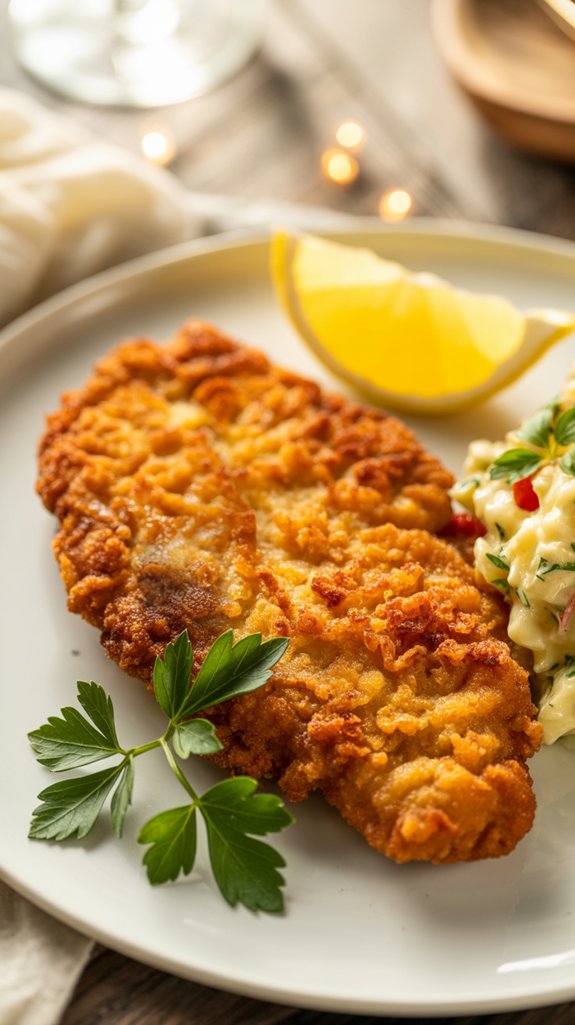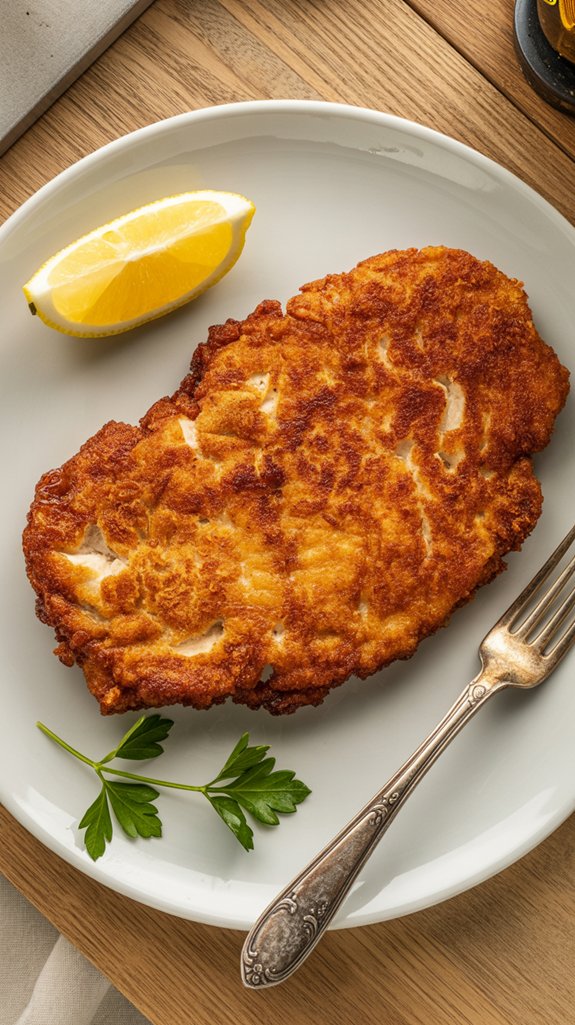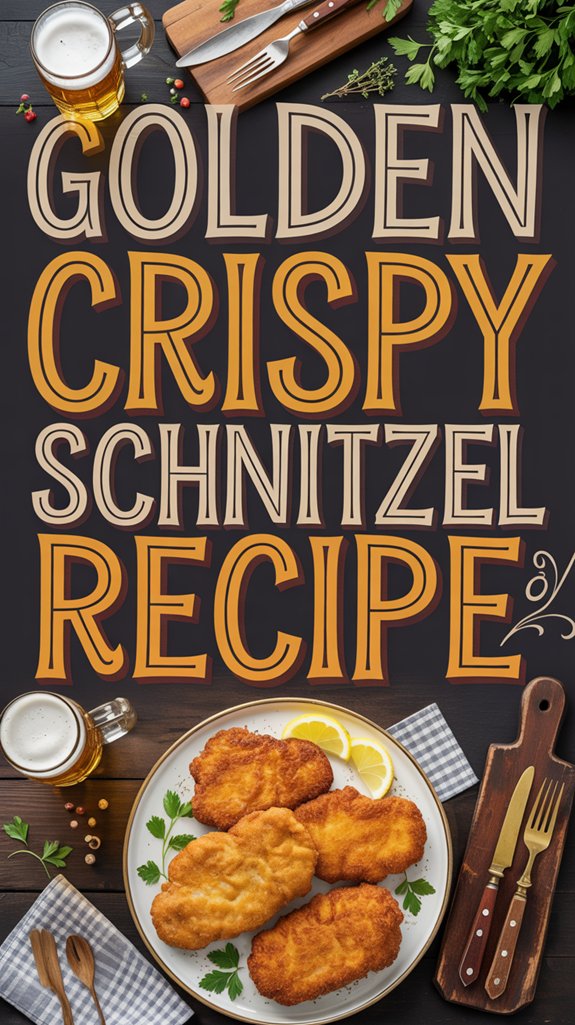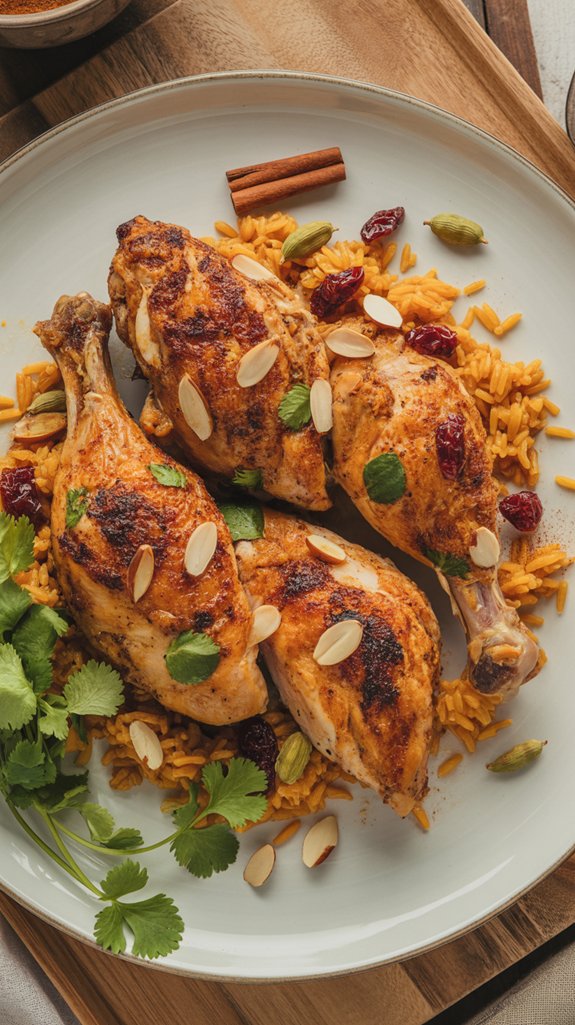Why You’ll Love This this Golden-Crispy German Chicken Schnitzel
This golden-crispy schnitzel transforms ordinary chicken breasts into something that’ll make you wonder why you ever bothered with plain grilled chicken. The combination of crushed Club crackers and panko creates this incredible crunchy coating that stays put, while the meat inside turns out so tender you can practically cut it with a fork. Whether you serve it with creamy mashed potatoes or turn it into chicken parmesan with melted cheese, this recipe gives you that restaurant-quality crunch at home without any fancy equipment or hard-to-find ingredients.
Ingredients List
This German chicken schnitzel needs just a handful of simple ingredients that you probably already have hanging around your kitchen.
- 2 large chicken breasts, halved
- 1/2 cup Club crackers, crushed
- 1/2 cup panko breadcrumbs
- 1/2 cup all-purpose flour
- 2 tablespoons Season-All salt
- 1 tablespoon onion powder
- 1 tablespoon garlic powder
- 2 large eggs
- 1 tablespoon milk
- Sea salt, to taste
- Vegetable oil (enough for half inch in skillet)
- Fresh is best – grab chicken breasts that are cold and fresh from the package since they hold their shape better when you’re trying to butterfly them
- Cracker swap – if Club crackers aren’t your thing, any buttery round cracker works just fine, though you might miss out on that particular crispy texture
- Oil matters – vegetable oil handles the high heat without smoking up your kitchen, but you could use canola or peanut oil too
- Portion control – this recipe serves about 4 people generously, so feel free to halve it if you’re cooking for fewer folks
- Prepare the coating mixture – Pulse Club crackers until coarsely crushed, then combine with panko breadcrumbs, flour, Season-All salt, onion powder, and garlic powder in a wide bowl.
- Set up egg wash – Crack eggs into a shallow bowl, add milk, and whisk until smooth.
- Butterfly the chicken – Cut each cold chicken breast in half by making shallow cuts from top to bottom, keeping the narrow side facing you.
- Pound to flatten – Use a meat mallet to pound each piece until roughly doubled in size, being careful not to make them too thin.
- Season generously – Sprinkle liberal amounts of sea salt on both sides of each flattened piece.
- Heat the oil – Add vegetable oil to a large skillet until it reaches about half an inch deep.
- Bread the chicken – Dip each piece in egg mixture until fully coated, then press into breadcrumb mixture for even coverage.
- Fry carefully – Place breaded chicken in hot oil (laying away from you to avoid splashing) and cook for about 2 minutes per side until golden.
- Optional warming – Keep finished schnitzels warm in a 325°F oven for 10-15 minutes on a cookie sheet to maintain crispiness.
- Serve immediately – Pair with mashed potatoes and gravy, or transform into chicken parmesan with tomato sauce, provolone, and parmesan cheese.
- Pork schnitzel – Use pork loin instead of chicken, pound it just as thin, and follow the exact same process for the traditional German sensation.
- Baked option – Spray your breaded chicken with cooking oil and bake at 400°F for about 15-20 minutes, flipping halfway through, though you’ll sacrifice some of that golden crispiness.
- Buttermilk soak – Let your pounded chicken sit in buttermilk for 30 minutes before breading for extra tender, tangy results that’ll make you wonder why you never tried this before.
- Different oils – Canola, peanut, or even avocado oil work great for frying, just make sure whatever you choose can handle the heat without smoking up your kitchen.
- German potato salad – The tangy, vinegar-based kind that’s served warm, not the mayo-heavy American version that’ll weigh you down after all that fried goodness.
- Spaetzle with butter – Those little German egg noodles are like tiny pillows of comfort, and they soak up any leftover oil from your plate in the best possible way.
- Simple arugula salad – Dress it with lemon and olive oil to cut through the richness, because sometimes you need something fresh to balance out all that crispy coating.
- Roasted asparagus or green beans – Keep the vegetables simple so they don’t compete with your star performer, just a little salt, pepper, and maybe some garlic.
- Lingonberry sauce or cranberry sauce – That sweet-tart combination is pure magic with fried chicken, and it’s traditional enough to make you feel fancy.
- Mashed potatoes and gravy – Because sometimes you just want to embrace the comfort food atmosphere completely, and there’s absolutely nothing wrong with that approach.
- Keep everything cold until the moment you cook – Cold chicken holds together better when you’re pounding it out, and cold oil temperature shocks create that perfect initial sear that locks in juices.
- Don’t skip the resting step after salting – Let those salted pieces sit for about 10 minutes before breading, because the salt draws out moisture that could make your coating soggy and sad.
- Press, don’t just dip – Really work those breadcrumbs into the meat with your palms, almost like you’re giving the chicken a little massage, because loose coating equals disappointing bald spots.
- Test your oil temperature with a breadcrumb – Drop a pinch of your coating mixture into the oil, and if it sizzles immediately without going crazy, you’re in the sweet spot around 350°F.
- Never crowd the pan – Cook in batches if you have to, because overcrowded chicken steams instead of fries, and steamed schnitzel is just expensive chicken nuggets.
- Listen for the sizzle to change – When that aggressive bubbling sound mellows out to a gentler simmer, your schnitzel is usually ready to flip.
- Let them drain on a wire rack, not paper towels – Paper towels trap steam underneath and turn your beautiful crispy bottom into something disappointingly chewy.
- Calories: 385 per serving
- Protein: 28g – excellent source for muscle maintenance and growth
- Carbohydrates: 18g – primarily from the breadcrumb coating
- Fat: 22g – includes heart-healthy fats from the cooking oil
- Fiber: 1g – modest amount from the breadcrumb mixture
- Sodium: 680mg – consider reducing Season-All if watching sodium intake
- Cholesterol: 145mg – from chicken and egg coating
- Iron: 8% daily value – supports healthy blood oxygen transport
- Calcium: 4% daily value – contributes to bone health
- Vitamin B6: 15% daily value – essential for brain function and metabolism
- Phosphorus: 20% daily value – important for bone and teeth health
- Niacin: 25% daily value – supports cardiovascular health and energy production
Step by Step Directions

Making authentic German chicken schnitzel is easier than you think when you follow these straightforward steps.
For restaurants preparing large batches, a commercial vacuum sealer can help preserve excess breaded chicken portions for future use while maintaining freshness and preventing freezer burn.
Substitutions and Variations
Additional Things to Serve With This Dish
This crispy, golden schnitzel deserves sides that can hold their own against all that delicious crunch.
Cooking Tips & Tricks (Chef’s Notes)
The difference between good schnitzel and great schnitzel often comes down to the little details that nobody tells you about.
Nutritional Facts
Each serving of German Chicken Schnitzel (recipe makes 4 servings) provides a substantial amount of protein while delivering the satisfying crunch that makes this dish irresistible.
Fun “Did You Know?”
Beyond its impressive nutritional profile, German Chicken Schnitzel carries fascinating stories that’ll make you appreciate this beloved dish even more.
I find it amazing that schnitzel originated in Austria, not Germany, with Wiener Schnitzel traditionally made from veal. The technique spread throughout Europe, with each region adapting it uniquely.
What surprises me most is that pounding the meat doesn’t just tenderize it—it actually breaks down muscle fibers, creating that signature tender texture.
The golden-brown color we love comes from the Maillard reaction, the same process that makes bread crusts and roasted coffee so irresistibly aromatic and flavorful.





